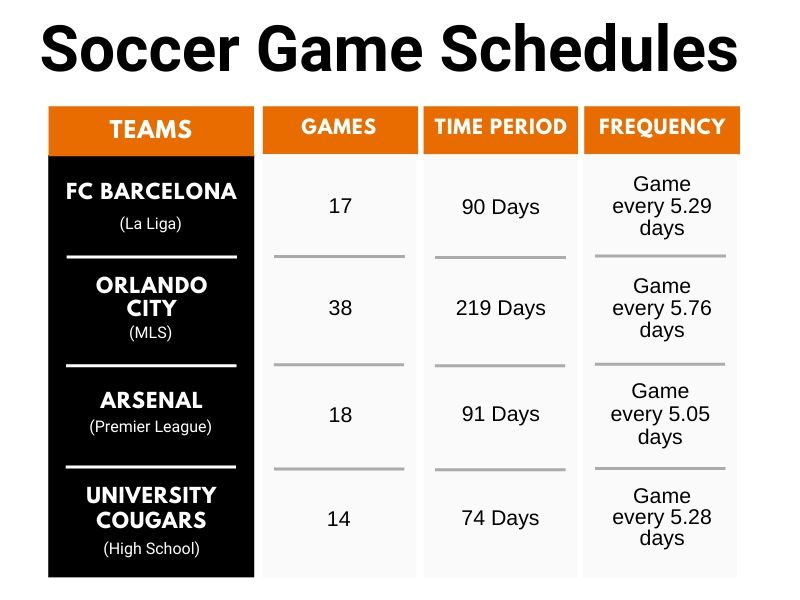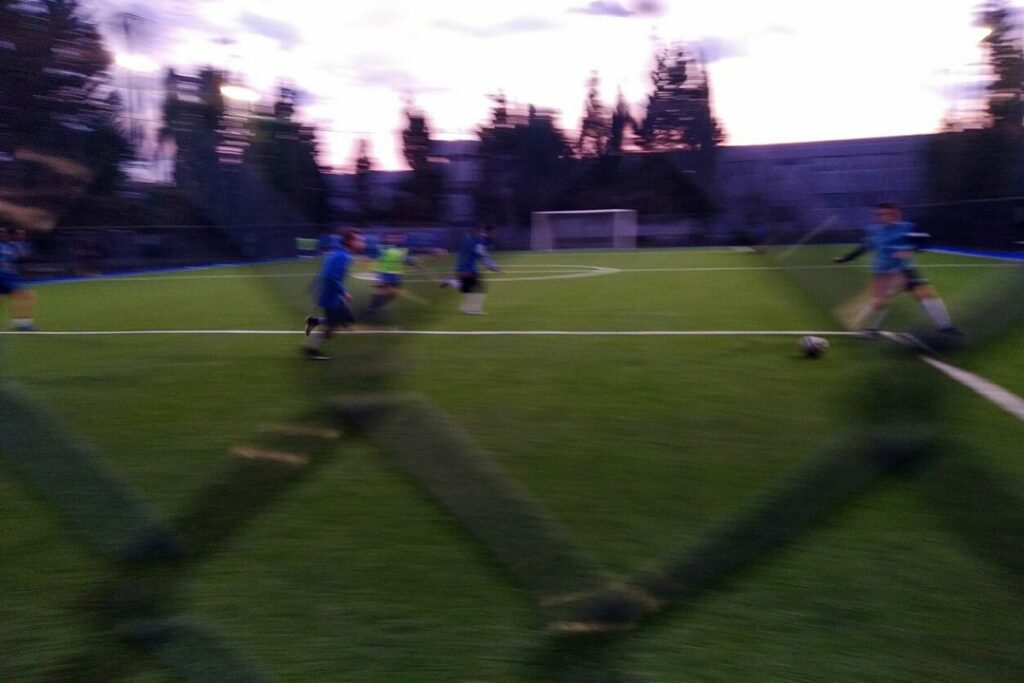The high school soccer schedule can be summed up like this… More Games = More Problems.
The high school athletes of today are asked to do far more than ever before. They are thrown into hyper competitive environment after hyper competitive environment, with each presenting it’s own challenges. As you can imagine these activities often compete amongst each other for the young athlete’s time and energy.
Whether it’s their schoolwork, soccer club, or high school team, everything they do today requires a high level of execution. The modern youth athlete is expected to take on an increasingly college like course load, with admission to universities becoming more and more competitive. On top of this they are subjected to a youth sports landscape that looks nothing like it used to even a mere 15 years ago. There are more practices, games, and tournaments than ever before and the stakes are higher to boot. With all of these stress inducing activities being forced on people that haven’t even been alive long enough to remember what dialup internet was, it begs the question…Is this what’s best for today’s youth?
Probably not, but instead of unpacking all of our misguided ways of developing the youth of today, I’m going to stay in my wheelhouse and speak on athletic development. Specifically, how the current structure of our high school soccer schedule is exposing players to unnecessary stress and injury.
So What’s Wrong With Today’s High School Soccer Schedule?
Short answer: They play way too many games in way too short of a time frame. This means they are playing in a constant state of fatigue, which exposes them to a higher likelihood of injury. Seems pretty cut and dry to me, but try telling the parents and coaches that.
Everyone knows who runs this massive youth sports industry…The Parents! The kids themselves are at best active participants and at worse they are treated almost like a chess piece, being moved around without any say towards an objective of “winning”. Now to be clear I do not think that the parents and coaches are doing any of these things on purpose. I think it’s simply a byproduct of years and years of a misguided sports culture. You see, the coaches of today were the athletes of yesterday. This means their experiences and ideas of training come from their time as a player. Combine that with the fact that High School Athletic Associations are trying to showcase athletes and produce results and we can start to see why these young kids are playing games at a higher frequency than their professional counterparts.
So to sum it up, we have an outdated view of training due to a lack of resources and copycat syndrome from the coaches, with parents who want the best for their kids but go about it with a more is better approach, topped off with an at best complicit High School Athletic Association system.
Now that’s a lot just to type, let alone fix. But this many issues in a system that is well meaning, charitable, and youth focused don’t just happen in isolation. So what’s the real problem with the way we structure youth sports, specifically the modern high school soccer schedule?
A lack Of Information!
I think that there is just a lack of information. The actual decision makers are not up to speed on the risks associated with a high frequency of training. Combine this with the fact that most people educated on the topic are at the higher levels and this is what you get. There aren’t many strength and conditioning coaches in the youth ranks. Heck, even private schools with big budgets barely have one on staff. So there isn’t a lot of opportunities to either educate or manage the issues surrounding a high match frequency.
The parents mean well but for some reason think that more is better when it comes to training. I think they are obviously the driver of the industry, literally and figuratively. However, if you were to tell them that they are potentially exposing their child to a higher chance of injury, I believe they would not be so willing to cheer on multiple games a week. I can’t answer why the state athletic associations assign these schedules. You would assume that there is a rhyme or a reason to why they think a youth soccer athlete should be competing as frequently as a professional, but who knows. There are a lot of high school soccer schedules to coordinate and you need to justify a state champ. That’s pretty hard to do if a team only plays 7 games before the District Championships start.
Regardless of how this lack of information exists, I think it’s important to understand why this amount of games is a problem to begin with. So, if you’re still skeptical, I encourage you to keep reading and see what the data says.
What Does The Data Say On This Topic?
The data is out there and it’s pretty clear, high levels of fatigue and training load lead to increased injury rates. In the case of youth athletes this requires even more consideration because they are still developing their physical and movement capabilities. When we subject the muscles, tendons, and ligaments to volumes of activity outside of the individuals maximal recoverable volume the outcomes are not good. Now when we ask an athlete to repeatedly do that over the course of a competitive season things really get shaky.
One particular study from The American Journal of Sports Medicine compared the effects on physical performance and injury rates when soccer players competed twice per week as opposed to once. What they found was that the injury rate was significantly higher when playing 2 matches per week. When players competed twice per week there were 25.6 injuries for every 1000 hours of exposure. As opposed to only 4.1 injuries per 1000 hours of exposure when only one match was played.
A similar study was done to follow up on these results and what they found was quite interesting. This study analyzed 27 teams over 11 seasons and came to the conclusion that a congested competitive schedule was associated with an increased occurrence of muscle injuries. They found a correlation between a high match load and muscle injury rates and a subsequently high rate of ligament injuries in training following a sequence of matches.
But What About Youth Athletes Specifically?
Well in elite youth soccer players they have shown a decrease in performance during the second match played in a given week. Perceived levels of fatigue are also higher after the second competition in a 7 day period. If we step away from soccer and look at youth athletes collectively it gets a bit concerning. Athletes that participate in their sport for more than 8 months out of the year are more likely to experience an overuse injury. Those that train for more hours per week than their age are more likely to report an injury of any type. So, basically nothing positive comes from a high frequency competitive schedule.
One study of youth soccer players in the English Professional Development League theorized that the decrease in work rate for the second match in a 7 day period was because they haven’t yet developed the physical capacity and self-pacing strategies to consistently sustain match running performance levels. While a self pacing strategy is important in all sports, I can’t help but ask myself…Why are we emulating the pro game in youth soccer?
Let’s Look At The Schedules
If you’re still skeptical about their being anything wrong with the high school soccer schedule, prepare for my mic drop. I looked at the match frequency of soccer teams across all levels of competition. Personally, the results were eye opening especially when we consider the physical differences between youth and professional athletes. Check them out in the table below:

Note: For the table above I only considered the 2019 season. It’s important to point out that the MLS season is over, which is why Orlando City includes so many games. The La Liga and Premier League seasons are currently in progress. So, the included games reflect year to date competitions as of November 24th. The University Cougars are a local high school where I am located in Orlando. Due to the shortened high school soccer schedule I included their entire season for reference. I am confident that if you plug in any high school the results will be similar since the season length is the same across the country.
I purposefully did not include an entire season for both European club examples. This allows us to analyze a similar amount of games and timeframe when compared to a high school season. I urge you to really look at this table and ask yourself if this seems like a good idea. Essentially, when you account for variable match start times in a given day there is no significant difference in frequency. In fact, if we choose to split hairs and rank them, the high school team would rank 2nd for busiest competitive schedule. I don’t know about you but this seems off to me.
Imitation Is Not The Sincerest Form Of Flattery
With youth sports today we have a tendency to imitate what we see the pros doing. However, it is important to remember kids and teenagers are not miniature adults. They require special considerations when trying to improve physical qualities and engage in athletic competition. The study above stated one of the reasons performance decreases as competition frequency increases is because of a lack of physical capacity. This lack of capacity doesn’t mean you should up the conditioning work. It means you should let kids be just that…Kids!
Allow them the time to develop and get in years of solid training and fundamentals before exposing them to the intensities of the pro game.
How Do We Fix The High School Soccer Schedule?
To be honest I don’t know. The problem is complex, dealing with a longstanding sports culture and complicit high school athletic associations across the country. Everyone is competitive and competing within the same 365 days. The high school soccer season takes place between the fall and spring club seasons. Instead of taking this into account and adjusting accordingly, athletic associations choose to play it out. Sure you could make an argument for the rise in club sports being a big factor in all of this. But, in my opinion they have at least earned the right to be in the driver’s seat. All of the top talent is in the club soccer system, the athletes know it, the parents know it, and most importantly the college coaches know it. So, what do you expect these kids to do?
This does not mean I am giving soccer clubs a pass, but it is important to identify who is in charge here. Even still, who do you fault more?
- The profit focused business that provides a better product
- The tax funded system that has failed to stay informed and adjust
Youth sports clubs are businesses marketing a product. Our high schools are institutions that should have student wellbeing as priority number 1.
Even though the problem is systemic, there are many organizations out there attempting to educate the public and make change. As someone in the industry I can say that youth athletic development is becoming a popular topic. As the word spreads the changes will happen, but it will take time. Now, assuming that most of you reading this are young soccer athletes or a parent of one, my guess is you want to know what you can do to address this problem today.
Manage The Problem With A Strength & Conditioning Program
Basically…Get Strong, Get Explosive, and Get Fast. Spend a portion of the year developing general athletic qualities and you’ll be better off for it. You see, the more athletic individual is less likely to experience an injury. This is because they have a higher achievable output. Their body can physically produce more force and display better elasticity. So the activities in practice or games then become less relative work and the athlete is better able to handle the workload.
Instead of spending your summers going from soccer camp to soccer camp with private sessions in-between, try training to improve athletic performance. Since everyone wants to copy the professionals anyways, why don’t you get on a structured offseason strength and conditioning program? I can guarantee you that it will change your game more than 3 days of drills and catered lunches at a camp every could. For soccer players the sins of summer get paid for in the winter. Train accordingly.
For those of you looking to start an in-season or off-season program, check out what we offer here at EPOK. We design completely personalized training packages and offer online coaching for those of you not living in Central Florida.
In writing this article I hope that I can help spread this important information. A change has to happen because the kids deserve a well structured and research backed system. I don’t intend for this to come across as an attack, but rather an educational resource on what the science says about a congested competitive schedule. I encourage everyone reading this to do their own research and manage this problem in whatever way they see fit.
If you have any questions feel free to ask them here.
Best,
John Evans

